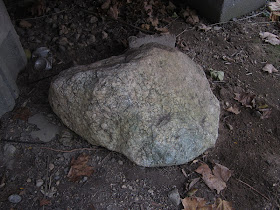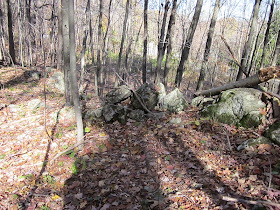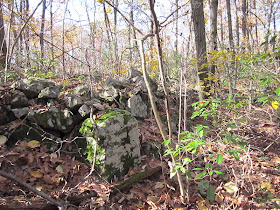Pages
▼
Monday, November 14, 2011
Friday, November 11, 2011
Bird Stone
I was thinking: that might be a turtle with long legs that have slid down the boulder, away from what could be a head, the left leg straight down, the other on its side, when I realize the stone next to it (just behind it in the photo) is another cultural motif, the bird stone...
That sure looks like a Bird Stone, doesn't it?
The (Stone) Origin of Stories
"The tenth day the boy started off, as usual, and, as each day he had gone farther for game than on the preceding day, so now he went deeper into the woods than ever. About midday the sinew that held the feathers to his arrow loosened. Looking around for a place where he could sit down while he took the sinew off and wound it on again, he saw a small opening and near the center of the opening a high, smooth, flat-topped, round stone. He went to the stone, sprang up on to it and sat down. He unwound the sinew and put it in his mouth to soften, then he arranged the arrow feathers and was about to fasten them to the arrow when a voice, right there near him, asked, "Shall I tell you stories?"
Poyeshaon looked up expecting to see a man, not seeing any one he looked behind the stone and around it, then he again began to tie the feathers to his arrow.
"Shall I tell you stories?" asked a voice right there by him.
The boy looked in every direction, but saw no one. Then he made up his mind to watch and find out who was trying to fool him. He stopped work and listened and when the voice again asked, "Shall I tell you stories?" he found that it came from the stone, then he asked, "What is that? What does it mean to tell stories?"
"It is telling what happened a long time ago. If you will give me your birds, I'll tell you stories."
"You may have the birds."
As soon as the boy promised to give the birds, the stone began telling what happened long ago. When one story was told, another was begun..."
Poyeshaon looked up expecting to see a man, not seeing any one he looked behind the stone and around it, then he again began to tie the feathers to his arrow.
"Shall I tell you stories?" asked a voice right there by him.
The boy looked in every direction, but saw no one. Then he made up his mind to watch and find out who was trying to fool him. He stopped work and listened and when the voice again asked, "Shall I tell you stories?" he found that it came from the stone, then he asked, "What is that? What does it mean to tell stories?"
"It is telling what happened a long time ago. If you will give me your birds, I'll tell you stories."
"You may have the birds."
As soon as the boy promised to give the birds, the stone began telling what happened long ago. When one story was told, another was begun..."
When it was almost night the Stone said, "Tomorrow all the people in your village must come and listen to my stories. Tell the chief to send every man, and have each man bring something to eat. You must clean the brush away so the people can sit on the ground near me."
Early in the morning the people of the village gathered around the stone and, when all was quiet, the stone began to tell stories, and it told till late in the afternoon, then it said, "I have finished! You must keep these stories as long as the world lasts; tell them to your children and grandchildren generation after generation. One person will remember them better than another. When you go to a man or a woman to ask for one of these stories carry something to pay for it, bread or meat, or whatever you have. I know all that happened in the world before this; I have told it to you. When you visit one another, you must tell these things, and keep them up always. I have finished."
And so it has been. From the Stone came all the knowledge the Senecas have of the world before this."
http://www.native-languages.org/senecastory6.htm
Bright Sun Light
Sometimes it happens
that a place you walked by a thousand times
looks different in the bright sun light.
Before the leaves fell,
before the sun sank low,
someplace where it was all dappled and shady,
is bright and sunny as you pass by...
It's November, but it's warm enough
For the quartz stones to sweat,
and it catches your eye and you go closer...
..and closer still.
Until you see the thing
"In a differnt light,"
as they say,
and you notice something
you didn't see before.
And you say to yourself,
"Well of course!
These things were meant to be seen
In every kind of light."
Above: In the Shade 8/12/2011
Wednesday, November 09, 2011
Fox Road and Kimberly Lane, Woodbury CT
This post at Rock Piles
precedes the posts:
Back to Fox Road and Kimberly Lane
and The Old Horse Field and the Outcrops
as well as Highfield Zigzag Rows
Highfield Zigzag Rows
Standing in the path looking east, a former field now planted with pines.
Here are some photos of a few segments of Zig Zag stone rows along a now closed road - or a part of road now closed - that has become part of Highfield Country Club. It's another of many Indian trails bordered on both sides by zigzag row firebreaks.These are carefully made stone rows rather than "thrown up against a rail fence" stones, the mythical version of the origin of zigzag "stone walls,"although over time more recent stones have been thrown into the "vee" of the firebreak, especially on the "field" side (left in the photo above) of this particular stone row (like many others).
Looking west across the zigzag stone row stone bordered Indian Trail.
Note the large boulders on the trail/road side of the closer zigzag row. In places where the trail did not become a road, I sometimes find a stack of stones that often are composed of boulders like these...
Note the large boulders on the trail/road side of the closer zigzag row. In places where the trail did not become a road, I sometimes find a stack of stones that often are composed of boulders like these...
Above: An intersecting zigzag stone row, looking south...
Above: Looking east from along the same intersecting zigzag segment toward the Indian Trail.
A related link:
http://wakinguponturtleisland.blogspot.com/2011/02/stone-wall-mythology-legends-and.html
http://wakinguponturtleisland.blogspot.com/2011/02/stone-wall-mythology-legends-and.html
Tuesday, November 08, 2011
The Old Horse Field and the Outcrops
The encircled area below is known in my family as the Old Horse Field on my great grandfather's farm. My Uncle Bob remembers an old barn foundation there and tells me that he was told that the barn burned - down with the horse inside it. I didn't find the foundation...
Revised Drawing 11/01/2022:
...and the "field" has been growing in with successive growth as long as I can remember. The zigzag row of stones at the edges of field, along the road has been plundered, as has the northern edge's row, but the outlines are apparent still.
Stone at northern edge
The western edge butts up against a north/south ridge of rocky outcrops that at first glance appear natural, but the closer one looks, the more it seems that human hands have been busy building rows, singling out certain stones that seem propped in position...
The most distinct stone row is at the base of the outcrops, more or less a linear row with some extensions back into the horse field, as above. The stone in the center of the above is a quite notable stone, inside a circle of stone, as in the close ups below... Above: these stones are actually just above the row at the edge of the field/base of the out crop.
A segment of an east/west row of stones (above), has a large "head stone" pointed east is about 25 feet long, suggesting perhaps a snake or serpent petroform. This row of stones, seen closer below, has an interesting stone at it's eastern end...
Visible to the south as I stood by this petroform was a (perhaps) 12 foot diameter circular mound that caught my eye; my first impression was that it two circular mounds, one to the east and one to the west:
The large mound sort of tuned me into others on this "terrace."
Above, looking north, the mound seemed just a "pile of stones."
Below, looking west, the mound's turtle-like nature became obvious to me...
Above: a lower shell, or plastron, supports a "head stone" with a suggestion of eyes,
and above a nuchal notch "marginal scute stone."
A friend who is the spiritual advisor of the most likely descendants of the People who most likely created this petroform suggested I offer some tobacco and gently clean it off to see if there are possibly stone representations of 13 scutes (moons) on the turtle's back...
Another of many "stone mounds."
This little terrace that contains these mounds has an eastern/western border stone row a little above it, suggesting containment of the cultural burning probably used to maintain the site.
I wonder what the other side borders...
(Above: a possible "bird stone" inspired this post:
"Quassapaug: a large pond in the n. w. part of Middlebury, partly in Woodbury; the source of Eight-mile river...Neither of the interpretations suggested by Mr. Cothren, —" Rocky pond," or "Beautiful clear water" — are admissible. Dr. Anderson, in Orcutt's Derby, xcvi, proposes qunnosu-paug 'pickerel pond,' to which the only objection is that after names of fish, -maug 'fishing place,' was used, instead of -paug 'pond,' or -tuck 'river.' The Rev. Azel Backus (Account of Bethlem, 1812, Ms) interpreted the name, as "signifying Little pond" — but he certainly was wrong: Quassapaug is not a small, but the largest pond in that region, and may have been denominated k'che-paug, i. e. 'greatest pond'—a name easily corrupted to Quassapaug (mod. Quaspaug)."
From: "Indian names of places" By James Hammond Trumbull (Pages 59-60)
Note on 11/01/22:
I almost replaced "stone mound(s): with Káhtôquwuk or Stone Prayer.
As I understand it, Káhtôquwuk means, allegorically, a 'Stone Prayer.'
A káhtôquwuk is a kind of stone pile,
a kind of stone heap, something that is heaped high, ceremonially, religiously,
by placing one stone above another stone.
Káhtôquwukansh is the plural of “Stone Prayers.”
http://wakinguponturtleisland.blogspot.com/2022/03/kahtoquwuk-stone-prayers.html
























































